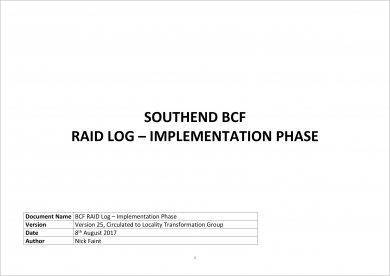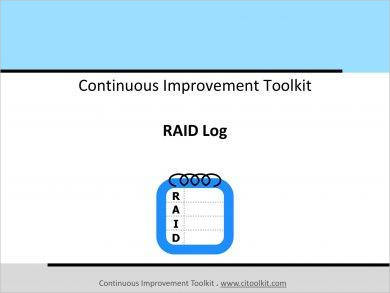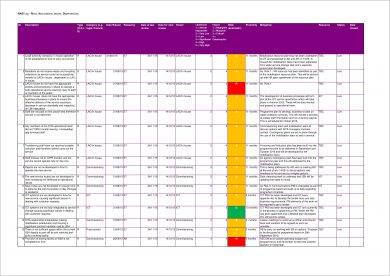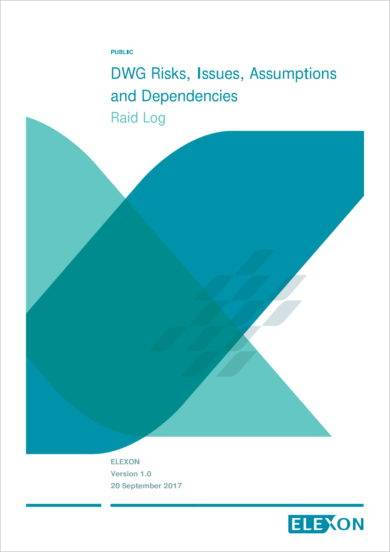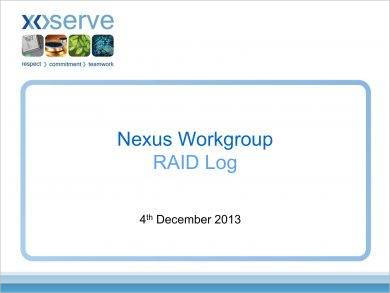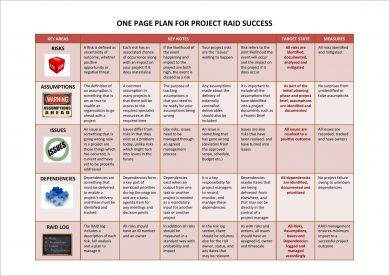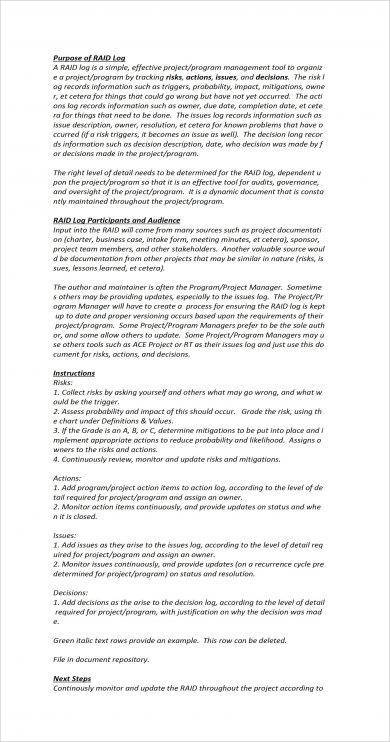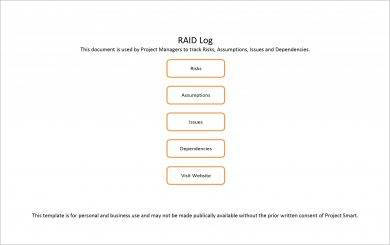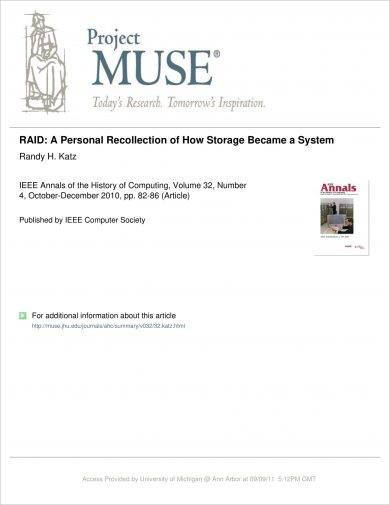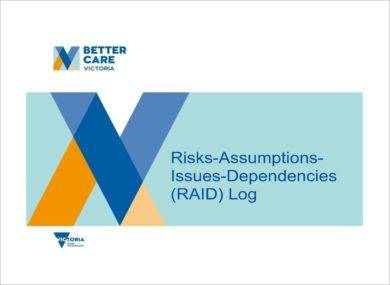9+ RAID Log Examples to Download
Before you start a project, you must first do some brainstorming and planning as these are critical when you are about to do a certain project.
You must identify the events that can have an adverse impact on the project if they occur, the things that you assume that may contribute to the success of the project, the issues or current matters that need to be considered or addressed, and the projects in which your project depends on or the projects that depend on your project. These things are summarized in a RAID log. You may also see activity log examples.
The risks, assumptions, issues, and dependencies of your planned project must be taken care of first so you will have a kick start and a proper action to take when starting your project. You may also like daily work log examples.
Want to create one but not sure how to start? Below are some comprehensive examples of RAID logs that would give you an idea on how to create one. Check them out now.
BCF RAID Log Example
Comprehensive RAID Log Example
Concise RAID Log Example
What Is a RAID Log?
A RAID log, or risks, assumptions, issues, and dependencies log, is a project planning tool you can utilize for effective project management. This is one of the most convenient and practical tools that you can apply before starting your project. It can be used as follows:
- Engage the whole team in identifying crucial issues that may have an impact on the project
- Engage with the management whenever their input or support is needed
- Perform an environmental scan during the initial planning phase
- Gather all the relevant matters that may affect the project in one place
- Keep the project organized and on track
- Focus project efforts and resources
- Assure stakeholders that the project is under control
- Evaluate and assess changing project conditions
RAID Analysis
This is analysis of the four key areas of project planning and management which are the risks, assumptions, issues, and dependencies.
1. Risks
This pertains to the events that will have an adverse effect on the project that they are going to work on. The risks must be evaluated based on the likelihood that they will occur as well as their impact on the project.
In determining the risks, you may ask the following question: “What events might occur that will have a negative impact on the project?” To address this, you can take action by implementing risk mitigation strategies based on the level of risk. You may also see reading log for kids examples.
2. Assumptions
These are the aspects of the project that you assume will be in place to help the project run although it cannot be guaranteed. There will be an impact on the project if they are proven wrong. Your guide question will be, “What exists, or do we presume to be true, that will, in a way, help our project to be accomplished?” You may also like mileage log examples.
You must constantly reassess your assumptions at regular intervals to ensure they are still valid and they are not wrong or else they will have a great impact on your project.
3. Issues
This refers to the issues or events that have an adverse impact on the project. They are risks that have eventuated, which you must control as soon as possible for the project to stay on track. To check if there are issues during your planning phase, you can ask, “What must we deal with to make the project run?” You may also check out food log examples.
After determining the issue, assess and take action that would contain or remove the issue and keep them from spreading across your different projects.
4. Dependencies
These are activities that you depend on before you can start or complete your project. This would also refer to the activities that may rely on the completion of your project. The factors may be internal or external events, suppliers, or partners. To clarify your dependencies, you must answer the question, “Who or what are we dependent on and who depends on us?” You might be interested in workout log examples.
You must also constantly monitor and manage the connection and dependencies to examine if you still continue to depend on them or they still continue their dependence on your project.
DWG RAID Log Example
Nexus Workgroup RAID Log Example
One-Page RAID Log Example
Running a RAID Analysis Session
In running a RAID analysis session, you must make sure that you gather your team with you, with their clear and set minds, ready for brainstorming and critical analysis. This does not require so much time; you can even have a RAID analysis session in just an hour if you know how to use your time wisely, only focusing on the important and vital parts of the simple analysis.
Here is a brief guide on what you can do during the RAID analysis session. This would help you maximize your time and discuss a lot of things within a short period of time.
1. Define the Scope
Firstly, you have to define the scope of your RAID analysis as well as clarify the objectives of your session. You must present the data and information in a way that can be easily understood by the team such as presenting relevant issues from a business impact assessment or SWOT analysis, presenting data from the organization’s quality management, presenting lessons learned from the previous sessions or projects, and reviewing the relevant rules and regulations related to the project.
2. Brainstorm
Then, engage the team in a brainstorming session and give ideas on the risks, assumptions, issues, and dependencies that might have an impact on the project. You must gather all the ideas using poster paper, whiteboard, sticky notes, or through the use of online applications, which are common nowadays given the increasing use of the Internet. Capture as many ideas as you can to have a comprehensive overview as possible. You may also see weekly workout log examples.
3. Collate
After gathering all the ideas from the team or small groups, you must review these ideas, group those in a similar topic, delete the duplicates, and remove those that are not related to the project you are currently working on. This is like gathering only those that are relevant and assigning them into their proper categories or different subtopics. You may also like printable workout log examples.
4. Know Your Priorities
The team must know their priority and must learn how to prioritize the activities. You can cast a vote to ask people the items that they consider the most important and the things that must be done first.
After, you must assess the voted ideas and rate from low to high based on their potential impact on your project you are working on. This will help you prioritize the important and urgent matters and give you an idea on where to focus the most effort and resources. You may also check out printable mileage log examples.
5. Create an Action Plan
Given all the priorities your team had identified and voted, the next step is to identify the steps to manage each priority through an action plan. In your action plan, you must also consider discussing on how to prevent or control the risks, monitor and verify the assumptions, deal with issues, and monitor and manage dependencies. It is better that you assign responsibilities to each of the members of the team with a given deadline or time frames for the completion of each task.
6. Share the Report
Lastly, do not forget to compile the results of your RAID analysis as you can use this in your planning and monitoring as well as a basis for future RAID analysis that you may be conducting some time in the future. In brief, it must contain the priority items, the planned actions, those responsible for the actions, and the time frames for the implementation of those actions. You might be interested in blood pressure log examples.
Project Dependency RAID Log Example
Project Manager RAID Log Example
Benefits of RAID Log
RAID logs provide you with the following benefits:
1. It provides a number of viewpoints
A RAID log is important as it provide you a number of viewpoints. You can watch your plans in different perspectives and you can always weigh several alternatives. With the help of the whole team, you can easily identify those that are relevant over those that are not and you will know the priorities and urgent matters over those that are not of priority. You may also see workout log Excel examples.
2. It helps you to keep in control
Through RAID log, you and your team are in control. When you feel like you are moving away from the target toward your goal, you can always make adjustments and put an extra effort to stay on track.
3. It enables you to spot and manage risks
Risks are constant and cannot be removed especially those coming from outside factors. However, with RAID log, you can easily identify the risks and manage or control them so this will become your strength.
4. It enables you to spot and manage issues
Similarly, there are also certain issues that are caused by outside factors in which you cannot totally eliminate. But what you can do is reduce them into something bearable and tolerable, and take action so it would not cause a great negative impact to the project that you are working on. You may also like free printable phone log examples.
5. It helps you achieve a consistent decision-making
Because RAID logs provide you an overall view of the possibilities that may happen when you make certain decisions, you can easily monitor your decision-making, keeping it consistent with all your other decisions in a single project. Moreover, it is expected that your decisions are sound enough given that you have the whole team with you doing the RAID log analysis. You may also check out petty cash log templates & examples.
6. It helps you review assumptions you have made
A RAID log is also of great help when you review the assumptions you have made. Reviewing your assumptions is highly encouraged so you would be updated on whether or not your assumptions are still applicable and valid for there are times that your assumptions are already obsolete and are no longer useful for the current project that you are working on. You might be interested in workout sheet examples.
7. It presents the project status
With RAID logs, you can easily check the status of your project, you can trace whether you are still on the schedule or beyond the general schedule and you will know what things you still need to do and those that you have already completed. You can also easily monitor the progress of each of the members of the team, and you can identify those people who are efficient in their workload and those that need help to accomplish the tasks assigned to them.
8. It gives you an understanding about the future
It also give you an insight and understanding about the future as you have already a guide which can give you a perception of what might happen next if a certain decision has been made.
9. It provides foundation for project schedules and plans
Lastly, RAID logs provide foundation for the schedule and plans of your project. You will be organized, and even the management, who may not be a part of your RAID analysis session, can easily understand if you put your plans into writing.
Project RAID Log Example
University of Waterloo RAID Log Example
Final Note
Given the examples of RAID log above as well as the important discussions on RAID logs, this will help you create an effective RAID log that you can use for the next project of your company.
Do not forget the steps in running a RAID analysis session which are as follows: define the scope, brainstorm, collate, know your priorities, create an action plan, and share the general report.
Lastly, remember to refer to the examples above whenever you need some assistance with regard to RAID logs.



